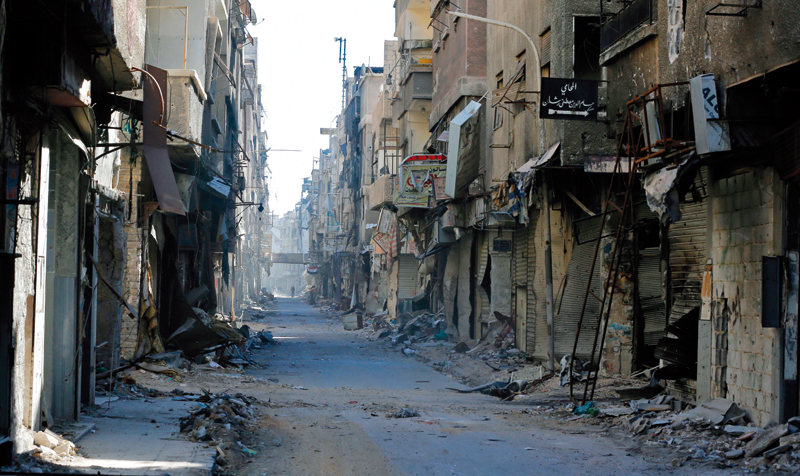

YARMUK: After years of fighting, crippling siege and bombardment, what was once the Palestinian diaspora’s largest urban settlement in southern Damascus has been reduced to a sea of debris.
Former residents of the Palestinian camp of Yarmuk are desperately counting on assistance from abroad to help raise the once-bustling neighbourhood back out of the rubble.
“We’ve lived through a terrifying nightmare,” said 46-year-old Amina, one of the camp’s very few remaining residents.
It “didn’t kill us, but now we need someone to rebuild the houses so our people and neighbours can return,” she said, wearing a long black robe and white headscarf.
In May this year, Syrian government and allied forces retook the neighbourhood, which had for years been the IS group’s only bastion in the capital.
Five months on, it is a ghost town where bulldozers have carved wide passages through a sprawling jumble of concrete debris and mangled steel rods.
Foreign “countries need to help us because we’re like a cripple who needs a crutch to walk again,” Amina said.
Founded in 1957 with tents for Palestinians forced to leave their homes by the establishment of Israel, Yarmuk grew into a sprawling neighbourhood of permanent structures that became home to 160,000 Palestinians, as well as Syrians.
In 2012, around 140,000 residents fled clashes, leaving the rest to face severe food shortages under government siege.
And three years later, IS extremists entered the area, bringing further suffering to remaining residents.
SALVAGED PLAYGROUND
Despite all this, dozens of families including Amina’s remained inside the camp, and others have since trickled back in.
A few children snake between the charred carcasses of buses and cars lining a street on their way to a school outside the camp.
In Amina’s street, one of the only roads in Yarmuk still inhabited, a recently returned neighbour has cobbled together a playground.
Abu Bilal has brought together swings, a small merry-go-round and a slide in an alley adorned with portraits of President Bashar al Assad and late Palestinian leader Yasser Arafat.
“I created this space so the neighbourhood’s children could be happy,” said the 54-year-old, who now works sweeping streets recently cleared of rubble.
“What I do is not enough for people to come back, but I hope donor countries” will help, he said.
In September, bulldozers started to clear Yarmuk’s main roads of rubble, with funding from the Palestine Liberation Organisation (PLO), and are expected to take another two months to finish clearing side streets.
“Rebuilding requires (foreign) countries and huge capital,” said Palestinian engineer Mahmud Khaled, a member of a committee overseeing the rubble clearing.
But Palestinian and UN officials say the camp’s future is still unclear, as Damascus has not yet given a green light for any re-building or officially allowed residents to return. — AFP
Oman Observer is now on the WhatsApp channel. Click here



